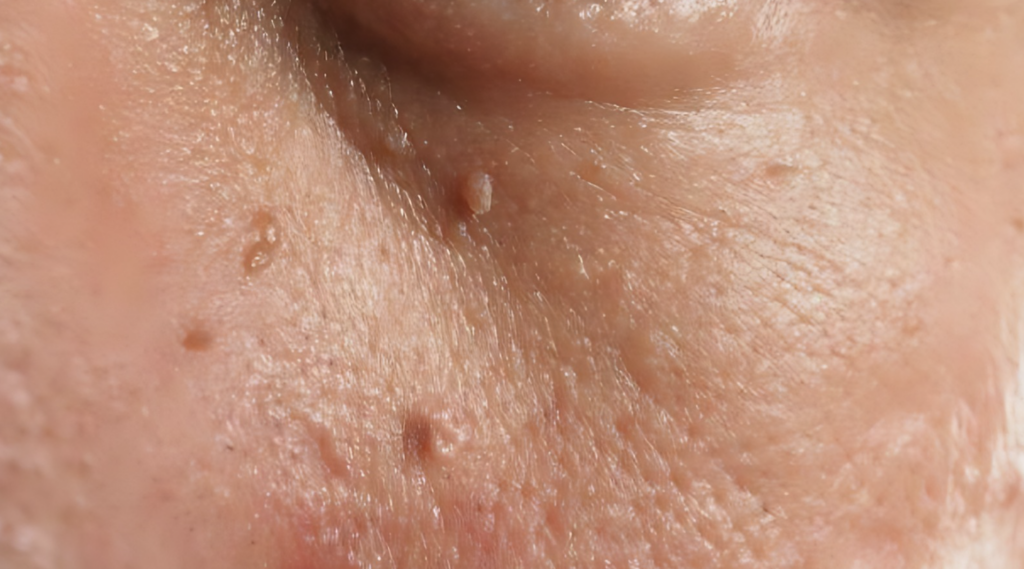Skin Care
Do Skin Tags Grow Back?
The pursuit of clear, beautiful skin may often feel like a difficult path, with one of the most annoying obstacles being the existence of skin tags. While these benign growths are generally harmless, they can raise a slew of questions and worries, the most pressing of which is whether or not skin tags grow back.
In this article, we will delve into the intricate structure of these seemingly harmless protrusions, unraveling the mysteries of their development, removal, and propensity for recurrence. Join us as we explore the terrain of skin tag regrowth, gaining knowledge to better understand and handle this common dermatological issue.

Understanding Skin Tags
Skin tags, commonly referred to as acrochordons, are small, benign growths on the skin. They are composed of collagen fibers, blood arteries, and skin cells, and can range in size from a few millimeters to several centimeters. While they are often harmless, they can be unattractive and uncomfortable if they scrape against clothing or jewelry.
What Are Skin Tags?
Skin tags are soft, fleshy growths that form when skin scrapes against skin or clothing. They are most typically found on the neck, eyelids, armpits, and groin, but can occur anywhere on the body. Skin tags are often flesh-colored or somewhat darker, with a short stalk connecting them to the skin’s surface.
Common Locations and Characteristics
Skin tags vary in size and shape, but they are often small and velvety to the touch. They can be smooth, wrinkled, or have a rough, uneven surface. Skin tags are most typically found in regions with friction, such as the neck, armpits, and groin. They may also appear on the eyelids and other areas of the face.
Causes and Risk Factors
Skin tags are assumed to be caused by a combination of hereditary and environmental factors, however, the specific reason is unknown. Skin tags are more common in elderly folks, as well as those who are overweight or diabetic. Hormonal changes during pregnancy may increase the likelihood of developing skin tags.
Friction is thought to play a role in the formation of skin tags. Skin tags are more common on areas of the body where skin rubs against skin or clothing, such as the neck, armpits, and groin. Skin tags can, however, appear in non-friction locations.
In conclusion, skin tags are frequent, harmless growths that can appear anywhere on the body. While they are often harmless, they can be unattractive and uncomfortable if they scrape against clothing or jewelry. Skin tags are most typically found in friction-prone locations, however they can also appear elsewhere on the body.

Medical Concerns and Diagnosis
Skin tags are generally innocuous and pose no significant medical risks. They may, however, cause discomfort, bleeding, or infection if they are placed in frequently touched or scratched regions.
When to See a Dermatologist
If a skin tag causes pain, inflammation, or bleeding, consult a dermatologist or healthcare provider. Furthermore, if the skin tag appears to be changing in size, form, or color, it is critical to seek medical attention because it could indicate a more serious illness, such as skin cancer.
Skin Tags vs. Other Skin Conditions
Skin tags are frequently confused with other skin disorders, such as moles and warts. Skin tags are normally benign growths, however moles and warts can be cancerous. Any abnormal growth should be evaluated by a dermatologist or healthcare expert to determine the proper diagnosis and treatment.
Diagnosis Process
A dermatologist or healthcare expert may typically detect a skin tag simply by inspecting it. In some circumstances, a biopsy may be required to rule out the presence of skin cancer. If the development is identified as a skin tag, therapeutic options can be considered. It is crucial to know that even if a skin tag is removed, it may re-grow in the same spot.
Treatment and Removal Options
Skin tags are normally innocuous and painless, although they can be a cosmetic issue for some people. Fortunately, there are various ways to remove them, both at home and in a professional setting. The next subsections will go over some of the most prevalent treatment and removal options, as well as the dangers and consequences that come with them.
Professional Removal Procedures
For those who prefer to have their skin tags removed by a professional, there are various in-office options available. Cryotherapy, commonly known as freezing, uses liquid nitrogen to freeze the skin tag, causing it to fall off within a few days. Cauterization uses heat to burn out the skin tag, whereas ligation ties off the base of the skin tag to cut off its blood supply. Surgical excision involves removing the skin tag with a knife or surgical scissors.
While these operations are generally safe and successful, there is a possibility of scarring and other risks including infection or bleeding. Before deciding on a procedure, consult with a healthcare expert about its risks and advantages.
At-Home Remedies and Risks
For those who wish to remove their skin tags at home, there are various alternatives. Tea tree oil and apple cider vinegar are two common home treatments that are supposed to help remove skin tags. However, little scientific data supports their usage, and the FDA does not regulate these products for skin tag removal.
Complications associated with at-home skin tag removal include infection, scarring, and bleeding. It is critical to follow instructions precisely and seek medical help if difficulties emerge.
Post-Removal Care and Complications
To avoid difficulties, regardless of the procedure used for skin tag removal, the affected region must be properly cared for. This may involve keeping the region clean and dry, avoiding tight clothing or jewelry that may irritate the skin, and using an antibiotic ointment to prevent infection.
Any skin tag removal treatment might result in complications such as bleeding, infection, and scarring; if any of these symptoms appear, get medical attention immediately. It is also critical to consult with a healthcare expert if the skin tag grows back or new skin tags emerge.

Prevention and Recurrence
Can Skin Tags Grow Back?
While skin tags are harmless and easily treated, they frequently grow back. Despite effective removal treatments such as freezing or cauterization, additional skin tags may develop over time, especially if there are predisposed factors such as obesity, genetics, or insufficient removal of the complete skin tag. As a result, it is critical to take preventive measures to limit the likelihood of skin tags developing back.
Preventive Measures and Lifestyle Changes
Preventive actions and lifestyle modifications can help lessen the probability of skin tags recurring. Here are some strategies to keep skin tags from recurring:
- Clothing: Avoid wearing tight-fitting garments that rub against your skin. Friction can cause skin tags to develop, particularly in locations where skin rubs against skin, such as the neck, armpits, and groin.
- Jewelry: Avoid wearing jewelry that rubs against your skin, such as necklaces or bracelets. Friction can cause skin tags to form.
- Excess weight: Maintaining a healthy weight can help lower the risk of developing skin tags. Obesity is a major risk factor for skin tags.
- Regular exercise can assist increase blood flow and lower the risk of skin tags forming. Good blood flow promotes skin health and minimizes the likelihood of skin tag formation.
- Insulin: Keeping insulin levels normal can help lessen the likelihood of skin tags developing. High insulin levels increase the chance of skin tag formation.
- Scars: Avoid hurting the skin or leaving scars, as they can increase the probability of skin tags developing.
- Aging and menopause might increase the likelihood of skin tags developing. While it is hard to prevent aging, living a healthy lifestyle can help lessen the likelihood of developing skin tags.
To summarize, skin tags can grow again, but taking preventive measures and changing your lifestyle can help lessen the likelihood of recurrence.
Conclusion
Finally, the journey into the strange world of skin tags gives us a full picture of how they grow and how often they can come back. Even though the thought of skin tags coming back might be scary, people can start their skincare journeys with confidence and knowledge thanks to our study. Remember that being aware of the risk and taking steps to avoid it, like using the right skin care products and regularly checking for growths, can greatly lower the chance of skin tags to grow back.
To get clear, healthy skin, it can also be very helpful to talk to a doctor or nurse about your specific needs and possible treatment options. Finally, people can deal with the difficulties of skin tag care with confidence and strength if they are aware of them and take action. This will help them to live a life without having to deal with skin tags.
Trusted Health, Wellness, and Medical advice for your well-being



